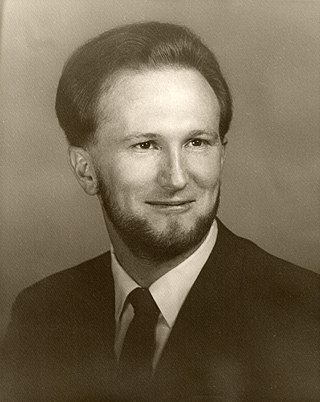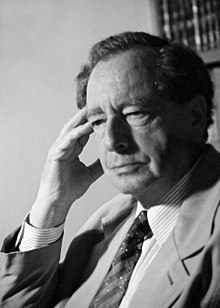The Copenhagen interpretation is a collection of views about the meaning of quantum mechanics, stemming from the work of Niels Bohr, Werner Heisenberg, Max Born, and others. While "Copenhagen" refers to the Danish city, the use as an "interpretation" was apparently coined by Heisenberg during the 1950s to refer to ideas developed in the 1925–1927 period, glossing over his disagreements with Bohr. Consequently, there is no definitive historical statement of what the interpretation entails.

The many-worlds interpretation (MWI) is a philosophical position about how the mathematics used in quantum mechanics relates to physical reality. It asserts that the universal wavefunction is objectively real, and that there is no wave function collapse. This implies that all possible outcomes of quantum measurements are physically realized in some "world" or universe. In contrast to some other interpretations of quantum mechanics, the evolution of reality as a whole in MWI is rigidly deterministic and local. Many-worlds is also called the relative state formulation or the Everett interpretation, after physicist Hugh Everett, who first proposed it in 1957. Bryce DeWitt popularized the formulation and named it many-worlds in the 1970s.
Materialism is a form of philosophical monism which holds that matter is the fundamental substance in nature, and that all things, including mental states and consciousness, are results of material interactions of material things. According to philosophical materialism, mind and consciousness are caused by physical processes, such as the neurochemistry of the human brain and nervous system, without which they cannot exist. Materialism directly contrasts with idealism, according to which consciousness is the fundamental substance of nature.

Physics is the natural science of matter, involving the study of matter, its fundamental constituents, its motion and behavior through space and time, and the related entities of energy and force. Physics is one of the most fundamental scientific disciplines. A scientist who specializes in the field of physics is called a physicist.
Reality is the sum or aggregate of all that is real or existent within the universe, as opposed to that which is only imaginary, nonexistent or nonactual. The term is also used to refer to the ontological status of things, indicating their existence. In physical terms, reality is the totality of a system, known and unknown.
An interpretation of quantum mechanics is an attempt to explain how the mathematical theory of quantum mechanics might correspond to experienced reality. Quantum mechanics has held up to rigorous and extremely precise tests in an extraordinarily broad range of experiments. However, there exist a number of contending schools of thought over their interpretation. These views on interpretation differ on such fundamental questions as whether quantum mechanics is deterministic or stochastic, local or non-local, which elements of quantum mechanics can be considered real, and what the nature of measurement is, among other matters.

Hilary Whitehall Putnam was an American philosopher, mathematician, computer scientist, and figure in analytic philosophy in the second half of the 20th century. He contributed to the studies of philosophy of mind, philosophy of language, philosophy of mathematics, and philosophy of science. Outside philosophy, Putnam contributed to mathematics and computer science. Together with Martin Davis he developed the Davis–Putnam algorithm for the Boolean satisfiability problem and he helped demonstrate the unsolvability of Hilbert's tenth problem.
In philosophy, the philosophy of physics deals with conceptual and interpretational issues in physics, many of which overlap with research done by certain kinds of theoretical physicists. Historically, philosophers of physics have engaged with questions such as the nature of space, time, matter and the laws that govern their interactions, as well as the epistemological and ontological basis of the theories used by practicing physicists. The discipline draws upon insights from various areas of philosophy, including metaphysics, epistemology, and philosophy of science, while also engaging with the latest developments in theoretical and experimental physics.
Scientism is the view that science and the scientific method are the best or only way to render truth about the world and reality.
The relationship between Buddhism and science is a subject of contemporary discussion and debate among Buddhists, scientists, and scholars of Buddhism. Historically, Buddhism encompasses many types of beliefs, traditions and practices, so it is difficult to assert any single "Buddhism" in relation to science. Similarly, the issue of what "science" refers to remains a subject of debate, and there is no single view on this issue. Those who compare science with Buddhism may use "science" to refer to "a method of sober and rational investigation" or may refer to specific scientific theories, methods or technologies.
In theoretical physics, geometrodynamics is an attempt to describe spacetime and associated phenomena completely in terms of geometry. Technically, its goal is to unify the fundamental forces and reformulate general relativity as a configuration space of three-metrics, modulo three-dimensional diffeomorphisms. The origin of this idea can be found in an English mathematician William Kingdon Clifford's works. This theory was enthusiastically promoted by John Wheeler in the 1960s, and work on it continues in the 21st century.
John Earman is an American philosopher of physics. He is an emeritus professor in the History and Philosophy of Science department at the University of Pittsburgh. He has also taught at the University of California, Los Angeles, Rockefeller University, and the University of Minnesota, and was president of the Philosophy of Science Association.

Cosmology is a branch of physics and metaphysics dealing with the nature of the universe, the cosmos. The term cosmology was first used in English in 1656 in Thomas Blount's Glossographia, and in 1731 taken up in Latin by German philosopher Christian Wolff in Cosmologia Generalis. Religious or mythological cosmology is a body of beliefs based on mythological, religious, and esoteric literature and traditions of creation myths and eschatology. In the science of astronomy, cosmology is concerned with the study of the chronology of the universe.
Karen Michelle Barad is an American feminist theorist and physicist, known particularly for their theory of agential realism.

Alwyn van der Merwe is an American theoretical physicist. He is Emeritus Professor of Physics in the Department of Physics and Astronomy, University of Denver.
In the philosophy of science, structuralism asserts that all aspects of reality are best understood in terms of empirical scientific constructs of entities and their relations, rather than in terms of concrete entities in themselves.
Robert Weingard was a philosopher of science and professor of philosophy at Rutgers University.

In physics and the philosophy of physics, quantum Bayesianism is a collection of related approaches to the interpretation of quantum mechanics, the most prominent of which is QBism. QBism is an interpretation that takes an agent's actions and experiences as the central concerns of the theory. QBism deals with common questions in the interpretation of quantum theory about the nature of wavefunction superposition, quantum measurement, and entanglement. According to QBism, many, but not all, aspects of the quantum formalism are subjective in nature. For example, in this interpretation, a quantum state is not an element of reality—instead, it represents the degrees of belief an agent has about the possible outcomes of measurements. For this reason, some philosophers of science have deemed QBism a form of anti-realism. The originators of the interpretation disagree with this characterization, proposing instead that the theory more properly aligns with a kind of realism they call "participatory realism", wherein reality consists of more than can be captured by any putative third-person account of it.

Ivor Robinson was a British-American mathematical physicist, born and educated in England, noted for his important contributions to the theory of relativity. He was a principal organizer of the Texas Symposium on Relativistic Astrophysics.

The Quine–Putnam indispensability argument is an argument in the philosophy of mathematics for the existence of abstract mathematical objects such as numbers and sets, a position known as mathematical platonism. It was named after the philosophers Willard Quine and Hilary Putnam, and is one of the most important arguments in the philosophy of mathematics.








